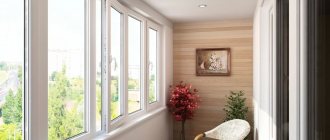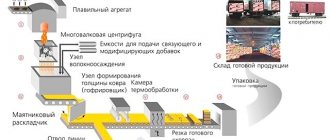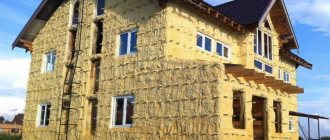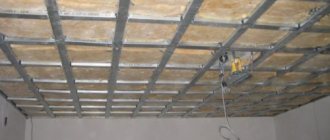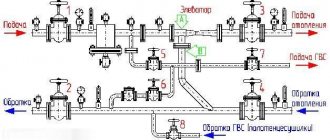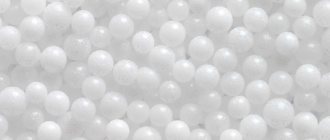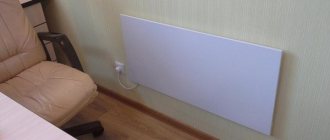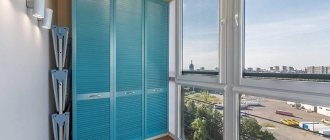The use of a balcony (loggia) as an additional room with functions that are not typical for it - as a greenhouse, kitchen, recreation area or study has become almost universal in recent years. With the advent of PVC structures, which make it possible to quickly and efficiently perform glazing with 2-3-layer double-glazed windows, which perfectly retains heat, insulating a balcony from the outside or inside with your own hands can quite successfully solve these problems.
But a balcony (loggia) is a small room. Therefore, high-quality insulation, especially in the northern regions, leads to a critical reduction in its area due to the thickness of the insulation and finishing materials.
There is a need for external insulation, which allows not only to save space but also to solve a number of technical problems associated with moving the “dew point” beyond the perimeter of the balcony area. In this article we will tell you how to insulate a balcony from the outside.
External insulation: pros and cons
When talking about insulating a balcony from the outside with your own hands, with the exception of balconies located on the highest floors, it is impossible to insulate the entire balcony (loggia) from the outside. In the vast majority of cases, we are talking about external insulation of the balcony parapet and (in very rare cases), external insulation of the balcony slab, which serves as a “roof” for the balconies of the upper floors.
Among the advantages of external insulation, two main ones can be distinguished:
- Saving balcony space.
- Placing the “dew point” on the outer surface of the parapet fence helps to avoid condensation and mold formation on the balcony.
The disadvantages of external insulation are:
- The need to coordinate work on external insulation and changes in the design and appearance of the building facade with architectural, construction and housing and communal services authorities.
- Obtaining permission to carry out work.
- The need to attract specialists - industrial climbers or special equipment - aerial platforms.
- Limitation on the choice of materials for insulation.
- Significant increase in the cost of insulation work.
Is it possible to insulate a balcony from the outside yourself?
When planning such an event, it is worth deciding in advance who will perform it. You can insulate the outside with your own hands only when the apartment is on the first or second floor. Otherwise, you will need the help of specialists.
Read also: Rules of conduct in case of fire
If you insulate the parapet of the balcony base from the outside with your own hands, you need to be prepared for additional expenses. Events may require:
- Platform
- Forests.
- Stepladders.
On average, the cost of renting scaffolding in Moscow can be from 50 rubles per square meter.
Preparatory stage of work
Before starting work on insulating the parapet of a balcony (loggia) from the outside with your own hands, it is necessary to assess the volume of work to be done, the condition of the material from which the parapet is made, and calculate the cost of the work, taking into account the involvement of industrial climbers or the rental of special equipment. If the calculations received do not scare you and we are not talking about the price or the time spent on obtaining permission from regulatory authorities to make changes to the design and appearance of the building’s façade – then let’s get to work!
We have already written in an article devoted to do-it-yourself insulation of balconies in Khrushchev-era apartment buildings, about the difficulties in obtaining permission to carry out work associated with making changes to the external enclosing structure of a small balcony and the facade of the building. In addition to the lack of regulatory documents in Russian legislation that would provide for such a possibility and would make such insulation legal, it will also be necessary to coordinate the work with the owners of the apartment building, since the external walls and structures are the joint property of all owners of the apartment building.
Unauthorized changes entail not only dissatisfaction with neighbors, but the obligation to restore the façade structures to their previous form at your own expense. If you managed to obtain the necessary permits, then you can begin to carry out work.
How to insulate a balcony from the outside
Experienced owners believe that insulating the balcony from the outside is the best option for preserving internal heat. And they are absolutely right: after all, this saves up to 30% of all heating costs. In addition, in this way you can save space inside the room, which will inevitably be “eaten up” by the insulation during interior decoration.
However, for residents of high-rise buildings, external insulation of the balcony is only possible through the use of the services of industrial climbers. In addition, thermal insulation of a balcony from the outside often involves a complete change in its design and exterior - you need to be prepared for significant changes, among which there are, of course, many more positive ones.
Strengthening the parapet structure
The balcony parapet can be:
- Metal - from corrugated sheets, rods, metal strips, pipes - in old houses.
- From reinforced concrete slabs of “light” concrete - in panel houses starting from series 121.
- Made of brick - in most modern brick or monolithic-frame residential buildings.
The material from which the parapet is made plays a significant role in the choice of not only the insulation material, but also its thickness and installation methods.
If the balcony parapet is made of corrugated sheeting or metal welded structures, preliminary cladding of this metal structure from the side of the balcony (loggia) will be required - otherwise the metal “ribs” of the corrugated board will spoil the entire appearance of the insulated balcony and will serve as “bridges” of cold that will negate all your efforts.
In addition to installing an internal screen that will hide the metal structures (made of chipboard, plasterboard, PVC siding, plywood), it will be necessary to create a layer of insulation that would completely hide the elements of the metal structures, otherwise in winter they will freeze and the cost of heating the balcony ( loggias) will be excessive.
If the parapet is made of reinforced concrete slabs or bricks, everything is much simpler - no additional work will be required to change the design of the parapet.
Glazing
Glazing is the installation of a special window unit, most often made of plastic. If such a design were truly effective at containing heat, then additional insulation would not be required. The problem is that the described blocks increase the temperature by only a couple of degrees - plastic and double-glazed windows can only prevent precipitation and wind.
The window unit, the installation of which is accompanied by insulation of balconies and loggias, is a kind of “cover” - usually the extension is open, and after glazing it is closed on all sides. Then they begin complex insulation.
Material selection
Considering that the balcony structure is remote in 90% of cases, that is, it protrudes beyond the facade of the building (with the exception of recessed loggias), it experiences increased wind loads and the effects of precipitation.
Therefore, as insulation it is necessary to choose a material that is resistant to street moisture.
The best in this regard are penoplex, polystyrene foam or sprayed polyurethane foam. It is undesirable to use mineral wool as insulation.
It is hygroscopic - it absorbs and retains moisture well, it is heavy, inconvenient to work with and requires obligatory lathing. Therefore, it is better to abandon the idea of insulating the balcony from the outside with mineral wool.
Quite rarely used in DIY insulation of balconies and loggias, polyurethane foam is an ideal insulation material for balcony parapets made of welded metal structures or corrugated sheets. Due to the “flow around” polyurethane foam, all metal structures (corrugated sheet ribs) are immersed in the insulation and do not form “cold bridges”.
In addition, applying such insulation to corrugated sheets does not require the installation of any retaining structures. The only “disadvantage” is the high price. Both the insulation itself and the cost of applying it. It is unlikely that you will be able to perform such insulation with your own hands.
But, if you decide to rent special vehicles or a team of industrial climbers in order to insulate your balcony from the outside, then the costs of applying PPU in comparison with the specified work will be insignificant.
Finishing the facade of a balcony or loggia insulated from the street
The surface of a loggia or balcony, covered with thermal insulators, must not only be insulated, but also have a good aesthetic appearance. In addition, the insulation itself requires reliable protection from moisture and ultraviolet radiation, and some topcoats may have heat-saving characteristics.
The choice of finishing option depends on the type of insulation used, the preferences of the apartment residents, their financial capabilities, as well as on the overall composition - the balcony should fit well into the picture of the house as a whole.
In addition, you should consider how the finished area will be used. Will it be a full-fledged part of the apartment (an additional room) or will its role be a utility room?
There are several ways to apply finishing, but they are divided into two groups: dry cladding and wet plastering. Decorative boards or sheets made of various materials are used for cladding. All types of moisture-resistant plasters are suitable for plastering, which can be left as is or painted.
Sheathing with corrugated sheets
This option is the least energy-saving, since it is performed using metal coated with a layer of zinc and polymer paint. It is better to use a wooden or welded frame made of profiled pipe for fastening corrugated sheets, and non-flammable basalt wool as insulation. On the upper floors, it is more convenient to replace heat insulators with rolled materials - penofol or polyethylene foam.
Profiled sheeting.
If you use thin corrugated roofing sheeting and put old plywood or used OSB underneath it, then you can achieve significant savings. In this case, any available insulation is placed under the OSB.
Balcony covered with corrugated board.
The large area of one steel sheet allows you to cover the entire balcony in several steps, significantly simplifying installation. The color solutions that become available with the use of this material are more diverse and simplify the selection of a composition that will fit into the surrounding landscape.
Siding
This profile cladding material is made of vinyl or aluminum. Thanks to its strength, high chemical resistance and insensitivity to moisture, this solution used for cladding a balcony or loggia is the most durable. The material is not susceptible to corrosion and deformation, like corrugated sheeting, there is no delamination and light aging, like PVC, it is reliable during installation and operation - all only the most positive characteristics.
Siding.
It is worth adding to this that it does not burn at all, or burns, but weakly. Any type of insulation can be used under it, but it is advisable to combine aluminum strips with mineral wool. It must be borne in mind that the price solution of this method is the most expensive, but despite this, the largest percentage of balconies are sheathed with siding.
Finishing the balcony with siding.
Plastic lining
A board made of PVC is a heat insulator and can even be used with penofol, which will significantly save money. In addition, the polymer panel itself is cheaper than siding. Its installation is quite simple; even a non-professional can handle it. The most difficult operation is securing the starting bottom strip at the base of the loggia.
Plastic lining of various colors.
A variety of color options, absolute immunity to moisture and the price factor could make this finishing option the most optimal, but there are negative nuances:
- plastic burns;
- it slowly deteriorates from exposure to the sun and weather conditions;
- requires great care during installation and operation.
Balcony finished with plastic siding.
Decorative plaster
This type of finishing work is used more often on loggias and balconies with a brick parapet. The scope of work is related to the insulation of a concrete slab or masonry and subsequent final decoration. The main disadvantage of this solution is that it is convenient to carry out plastering work only while outside, and this is already dangerous and will require hiring industrial climbers.
You can use both penoplex and mineral wool under the plaster, but still, working with the first option of insulation is easier and more reliable.
The facade is covered with decorative plaster.
Insulation with foam plastic or penotex
Insulation of the outer wall of the parapet of a balcony or loggia does not require additional waterproofing, since moisture condensation does not occur on the outer wall; foam or penotex slabs can be glued to the outer surface of the parapet using any moisture-resistant adhesive construction mastic applied to the surface of the insulation slab with a comb spatula. The glued slabs are additionally fixed with dowels-“fungi” with a wide head.
Considering that the thickness of a foam or penotex slab rarely exceeds 50 mm. You don’t have to install a sheathing to attach the sheathing - an external decorative screen that will cover the insulation from the outside (unless it is PVC siding, which needs guides into which individual siding elements are inserted). Sheathing - (corrugated sheeting, waterproof plasterboard, sheet metal siding, cellular polycarbonate or other waterproof sheet materials) with which you decide to decorate the façade of your balcony from the outside, can be mounted on anchors 100-150 mm long, holes for which are drilled through the insulation and the outer parapet fencing .
The length of the anchor should not exceed the total thickness of the parapet fence and insulation, so as not to protrude inside the balcony.
Penoplex
Behind the incomprehensible name lies one of the types of extruded polystyrene foam. It differs from foam plastic in greater flexibility, resistance to pressure and moisture. The thickness of the material depends on the type of balcony or loggia - so, if the latter is combined, then 4-6 cm is enough. Non-combined loggias are insulated with slabs, the thickness of which ranges from 2-4 cm.
After gluing the insulation, either plasterboard, which is moisture resistant, or gypsum fiber sheets are used. When installing a floor screed based on sand and cement, they must cover the surface.
A foil-type polyethylene film 3 mm thick is used as a vapor barrier layer. As for creating a waterproofing layer, it is done only when the need arises.
Installation elements
Let's present step-by-step instructions for . At the beginning of the work, the window structure blocks are installed, after which the seams are sealed. For this purpose, special polyurethane foam is used. Insulating materials are attached to the surfaces with dowels. These areas include side or façade walls, ceilings, and floors.
Joints and vapor barrier
Any joints between structures should be repaired with toluene-free foam. It is enough to seal the joints between the insulation boards with ordinary adhesive tape. Further insulation of the balcony with penoplex includes the creation of a vapor barrier layer.
Methods
Methods of external insulation of a balcony include window insulation, namely the replacement of old worn-out window structures with new metal-plastic double-glazed windows. Insulation of balconies from the outside is carried out both from the front walls and from the ceiling and side walls.
Part of the insulation is carried outside, that is, practically to the street. With external insulation, not a continuous, but an interrupted thermal insulation layer is created. Uniformity in this case is not so important: some part is exposed in the outer areas, and the other remains inside. The complex creates the same layer, only not a single one, but consisting of several elements.
